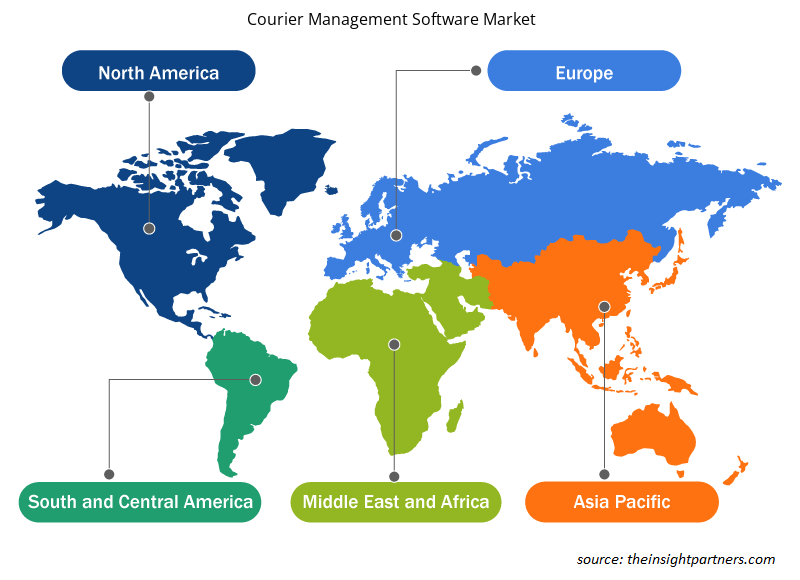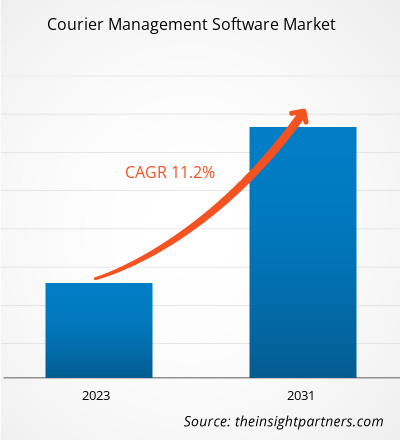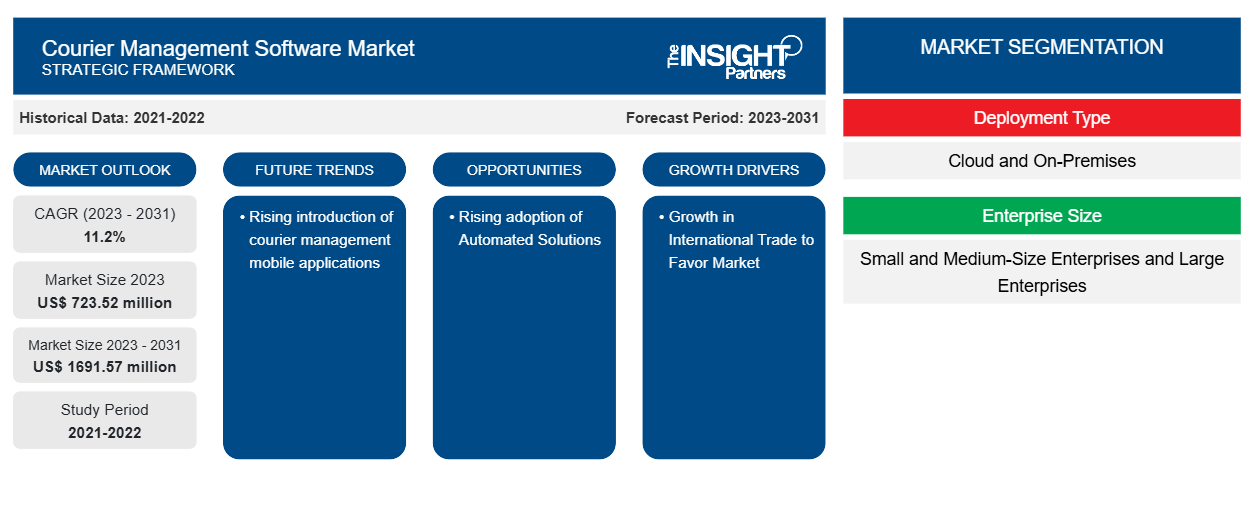글로벌 택배 관리 소프트웨어 시장 규모는 2023년 7억 2,352만 달러에서 2031년 1,691,570만 달러로 성장할 것으로 예상되며, 2023년에서 2031년까지 연평균 성장률 11.2%로 확대될 것으로 예상됩니다. 택배 관리 모바일 애플리케이션의 도입 증가는 택배 관리 소프트웨어 시장의 주요 트렌드로 남을 가능성이 높습니다.
택배 관리 소프트웨어 시장 분석
국제 무역의 성장은 택배 관리 소프트웨어 시장에 긍정적인 영향을 미칠 것으로 예상됩니다. 국제 무역이 증가함에 따라 효율적인 물류 및 배송 관리 솔루션에 대한 수요도 증가합니다.
택배 관리 소프트웨어 시장 개요
택배 관리 소프트웨어는 기업이 패키지나 제품에 대한 배송 주문을 효율적으로 관리하고 추적하도록 돕기 위해 설계된 포괄적인 소프트웨어 솔루션입니다. 이 소프트웨어는 배송 프로세스의 다양한 측면을 간소화하는 다양한 기능을 제공하여 궁극적으로 고객 만족도를 높이고 운영 효율성을 최적화합니다. 택배 소프트웨어는 배송에 대한 실시간 GPS 모니터링을 제공하여 기업이 배송 프로세스 전반에 걸쳐 패키지의 상태와 위치를 추적할 수 있도록 합니다.
귀하의 요구 사항에 맞게 이 보고서를 사용자 정의하세요
이 보고서의 일부 또는 국가 수준 분석, Excel 데이터 팩을 포함하여 모든 보고서에 대한 사용자 정의를 무료로 받을 수 있으며 신생 기업 및 대학을 위한 훌륭한 혜택과 할인 혜택을 이용할 수 있습니다.
-
이 보고서의 주요 시장 동향을 알아보세요.이 무료 샘플에는 시장 동향부터 추정 및 예측까지 다양한 데이터 분석이 포함됩니다.
택배 관리 소프트웨어 시장 동인 및 기회
국제 무역의 성장은 시장을 선호합니다
국제 무역의 성장은 택배 관리 소프트웨어 시장에 긍정적인 영향을 미칩니다. 국제 무역이 증가함에 따라 효율적인 물류 및 배송 관리 솔루션에 대한 수요도 증가합니다. 국제 무역은 국가 간의 상품 및 서비스 교환을 포함합니다. 운송, 창고 및 배송을 포함한 물류의 효과적인 조정 및 관리가 필요합니다. 택배 관리 소프트웨어는 이러한 프로세스를 간소화하고 효율성을 개선하며 상품의 적시 배송을 보장하는 데 중요한 역할을 합니다.
자동화 솔루션 채택 증가
전자상거래 기업의 택배 소프트웨어에 대한 투자가 증가하고 서비스로서의 소프트웨어(SaaS)의 인기가 높아지면서 택배 소프트웨어 시장이 앞으로 나아가고 있습니다. 이러한 소프트웨어 시스템은 비즈니스 운영을 간소화하고, 고객 커뮤니케이션을 개선하고, 배송에 대한 실시간 가시성을 제공하고, 라우팅 옵션을 최적화하는 등에서 중요한 역할을 합니다. 회사는 택배 소프트웨어를 기존 시스템에 통합하여 고객 주문 입력, 미수금, 실시간 배송 추적 및 계정 관리와 같은 다양한 프로세스를 자동화할 수 있습니다. 또한 경쟁력을 유지하기 위해 택배 소프트웨어 공급업체는 기술적으로 진보되고 고객 중심적인 가격 책정 전략을 구현하고 있습니다.customer-centric pricing strategies.
택배 관리 소프트웨어 시장 보고서 세분화 분석
택배 관리 소프트웨어 시장 분석에 기여한 주요 부문은 배포 유형과 기업 규모입니다.
- 배포 유형에 따라 시장은 클라우드와 온프레미스로 나뉩니다. 클라우드 세그먼트는 2023년에 더 큰 시장 점유율을 차지했습니다.
- 기업 규모에 따라 시장은 중소기업과 대기업으로 나뉩니다. 대기업 부문은 2023년에 더 큰 시장 점유율을 차지했습니다.
지역별 택배 관리 소프트웨어 시장 점유율 분석
택배 관리 소프트웨어 시장 보고서의 지리적 범위는 주로 북미, 아시아 태평양, 유럽, 중동 및 아프리카, 남미/남중부 및 중미의 5개 지역으로 나뉩니다. 북미는 2023년 택배 관리 소프트웨어 시장을 지배했습니다. 공급망 관리를 강화하는 택배 소프트웨어의 인기가 높아짐에 따라 필수 및 비필수 제품 모두의 온라인 쇼핑에 대한 종단 간 배송 요구 사항을 처리할 수 있는 안정적인 플랫폼에 대한 수요가 증가하고 있습니다. 이 지역의 상업 부문은 택배 소프트웨어 시장의 성장을 촉진하는 상당한 기술 발전을 목격하고 있습니다. 또한 북미 국가 전역의 산업 부문에서 기술이 빠르게 채택됨에 따라 이 지역의 택배 소프트웨어 시장이 확대되고 있습니다.
택배 관리 소프트웨어 시장 지역 통찰력
Insight Partners의 분석가들은 예측 기간 동안 택배 관리 소프트웨어 시장에 영향을 미치는 지역적 추세와 요인을 철저히 설명했습니다. 이 섹션에서는 북미, 유럽, 아시아 태평양, 중동 및 아프리카, 남미 및 중미의 택배 관리 소프트웨어 시장 세그먼트와 지리에 대해서도 설명합니다.

- 택배 관리 소프트웨어 시장에 대한 지역별 데이터 얻기
택배 관리 소프트웨어 시장 보고서 범위
| 보고서 속성 | 세부 |
|---|---|
| 2023년 시장 규모 | 7억 2,352만 달러 |
| 2031년까지 시장 규모 | 16억 9,157만 달러 |
| 글로벌 CAGR (2023-2031) | 11.2% |
| 역사적 데이터 | 2021-2022 |
| 예측 기간 | 2023-2031 |
| 다루는 세그먼트 |
배포 유형별
|
| 포함된 지역 및 국가 |
북아메리카
|
| 시장 선도 기업 및 주요 회사 프로필 |
|
시장 참여자 밀도: 비즈니스 역학에 미치는 영향 이해
택배 관리 소프트웨어 시장은 소비자 선호도의 변화, 기술 발전, 제품의 이점에 대한 인식 증가와 같은 요인으로 인해 최종 사용자 수요가 증가함에 따라 빠르게 성장하고 있습니다. 수요가 증가함에 따라 기업은 제품을 확장하고, 소비자의 요구를 충족하기 위해 혁신하고, 새로운 트렌드를 활용하여 시장 성장을 더욱 촉진하고 있습니다.
시장 참여자 밀도는 특정 시장이나 산업 내에서 운영되는 회사나 기업의 분포를 말합니다. 주어진 시장 공간에 얼마나 많은 경쟁자(시장 참여자)가 존재하는지 그 규모나 전체 시장 가치에 비해 나타냅니다.
택배 관리 소프트웨어 시장에서 운영되는 주요 회사는 다음과 같습니다.
- 쿠리어 소프트웨어 유한회사
- 택배매니저
- 델리베리
- 데이터트랙 코퍼레이션
- 디지털 운송장
- 주요 소프트웨어 시스템
면책 조항 : 위에 나열된 회사는 어떤 특별한 순서에 따라 순위가 매겨지지 않았습니다.

- 택배 관리 소프트웨어 시장 주요 업체 개요를 알아보세요
택배 관리 소프트웨어 시장 뉴스 및 최근 개발
택배 관리 소프트웨어 시장은 1차 및 2차 조사 이후의 정성적, 정량적 데이터를 수집하여 평가합니다. 여기에는 중요한 기업 간행물, 협회 데이터 및 데이터베이스가 포함됩니다. 다음은 시장의 개발 목록입니다.
- 2023년 9월, 물류 서비스 제공업체인 Delhivery는 최근 'LocateOne'이라는 위치 인텔리전스 솔루션을 출시하여 기업이 주소 데이터, 옥상 정확도를 개선하고 사기를 줄이는 데 도움을 주었습니다. 이 새로운 기능은 OS1 플랫폼에서 Delhivery의 소프트웨어 제공의 일부입니다. OS1은 기업이 물류 및 공급망 운영을 효율적으로 운영할 수 있도록 전체 솔루션을 제공하는 소프트웨어 플랫폼입니다.
(출처: Delhivery, 보도자료, 2023)
택배 관리 소프트웨어 시장 보고서 범위 및 제공물
"택배 관리 소프트웨어 시장 규모 및 예측(2021–2031)" 보고서는 아래 영역을 포괄하는 시장에 대한 자세한 분석을 제공합니다.
- 범위에 포함된 모든 주요 시장 세그먼트에 대한 글로벌, 지역 및 국가 수준의 시장 규모 및 예측
- 동인, 제약 및 주요 기회와 같은 시장 역학
- 주요 미래 트렌드
- 자세한 PEST/포터의 5가지 힘 및 SWOT 분석
- 주요 시장 동향, 주요 업체, 규정 및 최근 시장 동향을 포괄하는 글로벌 및 지역 시장 분석
- 시장 집중도, 히트맵 분석, 유명 기업 및 최근 개발 사항을 포함하는 산업 환경 및 경쟁 분석
- 자세한 회사 프로필
- 과거 분석(2년), 기준 연도, CAGR을 포함한 예측(7년)
- PEST 및 SWOT 분석
- 시장 규모 가치/거래량 - 글로벌, 지역, 국가
- 산업 및 경쟁 환경
- Excel 데이터세트
최근 보고서
관련 보고서
사용 후기
구매 이유
- 정보에 기반한 의사 결정
- 시장 역학 이해
- 경쟁 분석
- 고객 인사이트
- 시장 예측
- 위험 완화
- 전략 기획
- 투자 타당성 분석
- 신흥 시장 파악
- 마케팅 전략 강화
- 운영 효율성 향상
- 규제 동향에 발맞춰 대응























 무료 샘플 받기 - 택배 관리 소프트웨어 시장
무료 샘플 받기 - 택배 관리 소프트웨어 시장